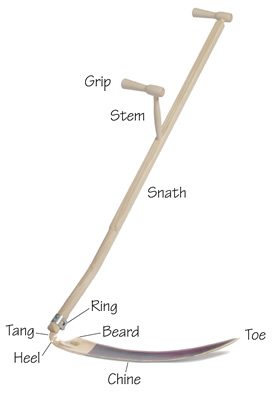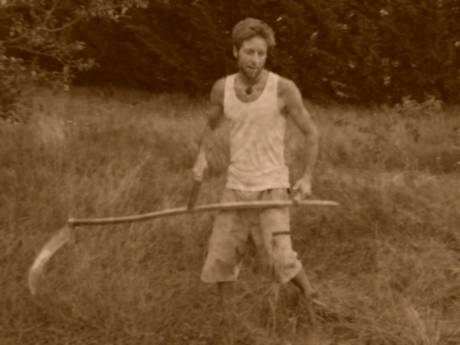Scything like it's 1809
Ever since a recent scything workshop held at his place, my father has been raving about the art of scything.
 The scythe is best known as the weapon of choice of the grim reaper, basically a long, curved metal blade on a wooden pole with handles. Traditionally used for mowing grass and harvesting cereal crops, the scythe has a long history in agrarian (and revolutionary) societies.
The scythe is best known as the weapon of choice of the grim reaper, basically a long, curved metal blade on a wooden pole with handles. Traditionally used for mowing grass and harvesting cereal crops, the scythe has a long history in agrarian (and revolutionary) societies.
Anyway, back to the story of the day, Christmas day as it happens.
In the spir it of the eccentric Sinclair Christmas, my parents decided to bring their scythes up to our place for a demonstration of this sophisticated mowing instrument. Once our hearty lunch was sufficiently digested and the heat of the day subdued, we got into the swing of it.
it of the eccentric Sinclair Christmas, my parents decided to bring their scythes up to our place for a demonstration of this sophisticated mowing instrument. Once our hearty lunch was sufficiently digested and the heat of the day subdued, we got into the swing of it.
At first glance the scythes looked much like any scythe but on closer inspection I realised that this model was somewhat different from the rustic old device I had seen gathering dust in the garage as a kid. For a start, this thing was light, very light when compared to the motorised scrub cutter I was accustomed to using. Secondly, the handles were mounted off the main shaft at a short distance rather than directly (sorry, not easy to describe).
The art of mowing with the scythe looks more like some kind of martial art or tai chi, a fluid yet repetitive dancing stroke described to me as "mopping the floor" rather than slashing at the grass.
Having spent 2 hours the previous evening exposed to the noxious fumes, irritating whine and incessant vibration of my 2 stroke brush cutter, the scything experience was delightful. I could hear the birds, breathe freely and even conduct a conversation. Imagine that! It helped that there were 2 of us working together. In further comparison to the brush cutter, it was quite obvious that a skilful scythe master would out perform the motorised counterpart.
Now I want my own one...
Respect to the scythe.

